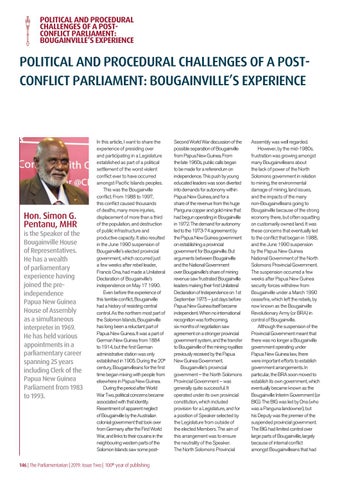POLITICAL AND PROCEDURAL CHALLENGES OF A POSTCONFLICT PARLIAMENT: BOUGAINVILLE’S EXPERIENCE
POLITICAL AND PROCEDURAL CHALLENGES OF A POSTCONFLICT PARLIAMENT: BOUGAINVILLE’S EXPERIENCE
Hon. Simon G. Pentanu, MHR
is the Speaker of the Bougainville House of Representatives. He has a wealth of parliamentary experience having joined the preindependence Papua New Guinea House of Assembly as a simultaneous interpreter in 1969. He has held various appointments in a parliamentary career spanning 25 years including Clerk of the Papua New Guinea Parliament from 1983 to 1993.
In this article, I want to share the experience of presiding over and participating in a Legislature established as part of a political settlement of the worst violent conflict ever to have occurred amongst Pacific Islands peoples. This was the Bougainville conflict. From 1988 to 1997, this conflict caused thousands of deaths, many more injuries, displacement of more than a third of the population, and destruction of public infrastructure and productive capacity. It also resulted in the June 1990 suspension of Bougainville’s elected provincial government, which occurred just a few weeks after rebel leader, Francis Ona, had made a Unilateral Declaration of Bougainville’s independence on May 17 1990. Even before the experience of this terrible conflict, Bougainville had a history of resisting central control. As the northern most part of the Solomon Islands, Bougainville has long been a reluctant part of Papua New Guinea. It was a part of German New Guinea from 1884 to 1914, but the first German administrative station was only established in 1905. During the 20th century, Bougainvilleans for the first time began mixing with people from elsewhere in Papua New Guinea. During the period after World War Two, political concerns became associated with that identity. Resentment of apparent neglect of Bougainville by the Australian colonial government that took over from Germany after the First World War, and links to their cousins in the neighbouring western parts of the Solomon Islands saw some post-
146 | The Parliamentarian | 2019: Issue Two | 100th year of publishing
Second World War discussion of the possible separation of Bougainville from Papua New Guinea. From the late 1960s, public calls began to be made for a referendum on independence. This push by young educated leaders was soon diverted into demands for autonomy within Papua New Guinea, and for a share of the revenue from the huge Panguna copper and gold mine that had begun operating in Bougainville in 1972. The demand for autonomy led to the 1973-74 agreement by the Papua New Guinea government on establishing a provincial government for Bougainville. But arguments between Bougainville and the National Government over Bougainville’s share of mining revenue saw frustrated Bougainville leaders making their first Unilateral Declaration of Independence on 1st September 1975 – just days before Papua New Guinea itself became independent. When no international recognition was forthcoming, six months of negotiation saw agreement on a stronger provincial government system, and the transfer to Bougainville of the mining royalties previously received by the Papua New Guinea Government. Bougainville’s provincial government – the North Solomons Provincial Government – was generally quite successful. It operated under its own provincial constitution, which included provision for a Legislature, and for a position of Speaker selected by the Legislature from outside of the elected Members. The aim of this arrangement was to ensure the neutrality of the Speaker. The North Solomons Provincial
Assembly was well regarded. However, by the mid-1980s, frustration was growing amongst many Bougainvilleans about the lack of power of the North Solomons government in relation to mining, the environmental damage of mining, land issues, and the impacts of the many non-Bougainvilleans going to Bougainville because of the strong economy there, but often squatting on customarily owned land. It was these concerns that eventually led to the conflict that began in 1988, and the June 1990 suspension by the Papua New Guinea National Government of the North Solomons Provincial Government. The suspension occurred a few weeks after Papua New Guinea security forces withdrew from Bougainville under a March 1990 ceasefire, which left the rebels, by now known as the Bougainville Revolutionary Army (or BRA) in control of Bougainville. Although the suspension of the Provincial Government meant that there was no longer a Bougainville government operating under Papua New Guinea law, there were important efforts to establish government arrangements. In particular, the BRA soon moved to establish its own government, which eventually became known as the Bougainville Interim Government (or BIG). The BIG was led by Ona (who was a Panguna landowner), but his Deputy was the premier of the suspended provincial government. The BIG had limited control over large parts of Bougainville, largely because of internal conflict amongst Bougainvilleans that had
